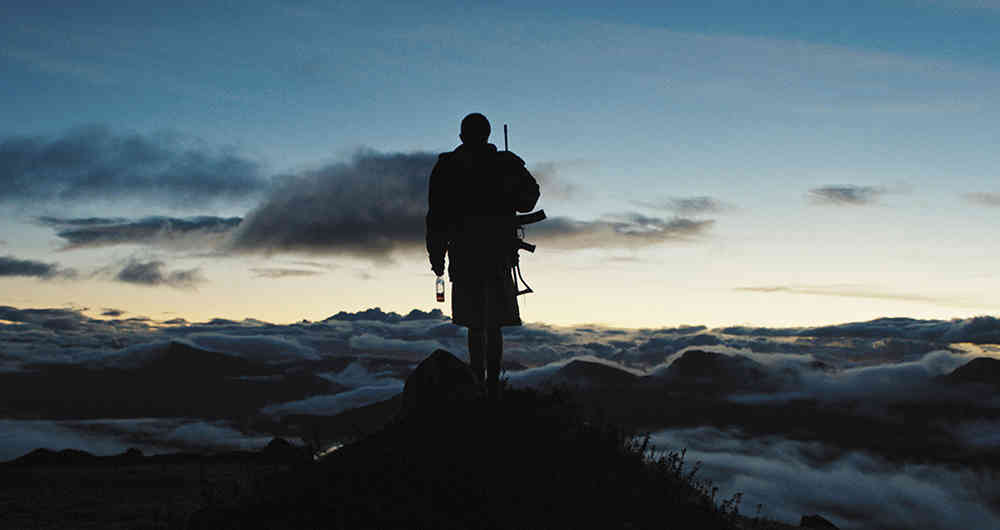
Monos takes place in an unnamed Latin American jungle, following eight teenaged guerrillas stationed in the mountainous jungles of the countryside as they train to become hardened soldiers and watch over American hostage Sara Watson (Julianne Nicholson), whom they’ve nicknamed “Doctora.” Juggling their responsibilities to “The Organization” to which they belong and their still present youthful exuberance, the children try to remain in control when disaster strikes.
The film is an unflinching portrayal of the brutality of armed conflict slowly draining the humanity from all of its participants, including the most innocent among us, children. When we first encounter the young soldiers of the film, the delicate balance between their innocence and burgeoning training as guerrilla soldiers is made clear. One instance features leader of the regimen Wolf (Julián Giraldo) and Lady (Karen Quintero) asking their superior for permission to date during a debrief. In this scene the two teens are at once disciplined and regimented as soldiers, displaying the order commanded of them in speaking during the debrief, but also bashful when formally making the request, giggling and bashful as you’d expect. Giraldo and Quintero do a wonderful job portraying the duality of young people forced into adult circumstances, but still displaying immaturity at times. This dichotomy is cleverly described by director Alejandro Landes within the film through a documentary on Germany where its creation of gummy bears is explained. Quality gummy bears must be hard enough to maintain their shape, but soft enough to chew. And so describes the child soldiers of Monos; hard enough to survive the rigors of being rebels, but still maintaining the soft innocence of youth beneath it all. As the film goes on and the rigors of conflict become more constant, the softer side of the teens dissipate and they succumb to their environment. Faced with the harsh consequences of failure, the brutal choices we see made by Bigfoot (Moisés Arias) make clear that angels can only remain themselves when surrounded by demons but for so long. The effects of war on the human psyche are well documented and established; feelings of depression, PTSD, and hatred for the other all result from harsh, prolonged conflict. The behavioral changes we witness among the kids in the film hammer home the fact that the death of the mind and spirit is just as much a consequence of war as physical death is. When you lose a piece of yourself to your wartime experiences, the tragedy is just pronounced. Monos also makes clear that soldiers are not the only people in war cursed to lose a piece of themselves, as we witness with Doctora’s story arc. When faced with a brutal choice in order to take advantage of the opportunity to escape, we see she doesn’t hesitate to display the same brutality as those she is being held captive by. Anyone caught in the wave of war succumbs to it, even if you’re an unwilling participant.
One interesting aspect explored in Monos that must be mentioned is the way that intimacy is presented as a way of coping with traumatic circumstances. The child soldiers frequently display spontaneous intimacy without regard to gender or even to enemy-ally classification, as we see when Swede (Laura Castrillón) attempts to seduce Doctora after the two survive an explosion during a battle between The Organization and military officials sent to rescue Doctora. While wartime sexual violence is often dissected and research, this sort of coping mechanism in conflict is not as spoken about, but is still very real. Trauma is often something that brings people together as a way to help each other through things or attempt to ease pain, and increased intimacy as a way of coping or bonding over shared traumatic experiences feels like a natural consequence of war. Including that here felt like a bold statement from the filmmakers.
Monos features the best cinematography so far this year. Director of photography Jasper Wolf displays a way of framing the faces of characters during moments of pain and trauma that particularly stands out. Whether it’s Doctora checking her face in a compact mirror, centering the camera’s focus on the eye of a dying cow, or Lady’s reaction after a devastating tragedy, Wolf perfectly utilizes the isolation of the face as a way of communicating raw emotion. The film’s use of the natural elements of the jungle in which the film is shot, from the sunlight peeking through the flora of the rainforest, or the majestic incorporation of fog and cloud topped mountains into the various shots onscreen also contributes to its visual prowess. Great transition shot as the troupe is leaving from the bunker into the jungle.
I watched Monos completely entranced watching these young teenagers navigate their very grownup circumstances and try to reconcile such weighty responsibilities with their innate immaturity. The ensemble performances of kids stuck in impossible circumstances, wavering back and forth between their innate nature and what they’ve been molded into was simultaneously moving and compellingly realistic. The film offers an intense look into a very real issue, bringing it to life on the big screen.
Image: NEON

